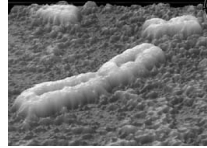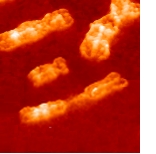
 | |
|
Since 2005, the NGFN scientists of the Leibniz Institute for Age Research (formerly the Institute of Molecular Biotechnology) in Jena have been significantly involved in sequencing the human X chromosome. In total, chromosome 8 contains only 793 protein-coding genes and is thus one of the gene-poor chromosomes.
A unique feature of human chromosome 8 is a region spanning approximately 15 million bases at one of its ends. This region varies greatly from person to person and is clearly different in humans and chimpanzees – and that although, on average, 98.7 percent of the genetic information is identical between the two species. “This region of chromosome 8 has in the past undergone more change and evolved more rapidly than other chromosomal regions. Only the male sex chromosome shows more variability,” explains Dr. Matthias Platzer, head of the study funded by the German Federal Ministry for Education and Research (BMBF).
 | |
|
Within the fast-evolving region on chromosome 8, genes are located which contribute to innate immunity in humans. Innate immunity refers to the non-specific defense mechanisms which function from birth on and which come into play shortly after the body has been invaded by a microbial attacker. One group of genes involved in these mechanisms is comprised of the defensin genes: They work as the body's own antibiotics that protect the organism from an infection with bacteria, fungi or viruses.
“Especially genes like the defensins constantly have to adjust to new environmental conditions. This is the only way they can provide effective protection against previously unknown kinds of bacteria. If these genes are located in regions with a high mutation rate, then the probability is higher that new variants evolve providing better protection,” says Matthias Platzer, commenting on the results of the current study. But this chromosome region of high mutation frequency could also be of significance for human evolution: The scientists found genes here that play a role in the development of the human nervous system.
For instance, the gene MCPH1 carries the blueprint for the protein microcephalin 1. If this protein is destroyed, the head circumference of the affected person is diminished. [[isn’t an important issue brain size?]] Moreover, the protein produced by the gene CSMD1 is involved in neuronal signal transfer. He adds, “These two genes indicate that the accelerated mutation rate at the end of chromosome 8 may have played an important role in the development of specific characteristics of the human nervous system. Homepage der Wissenschaftler
Homepage der Wissenschaftler




